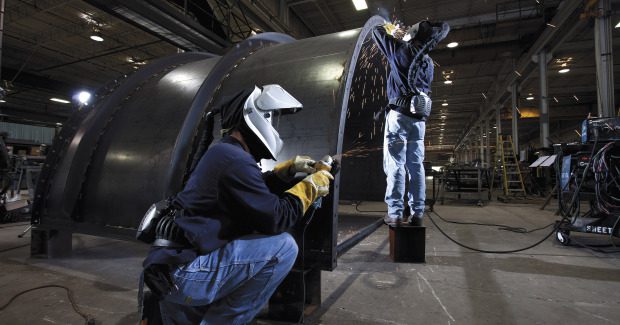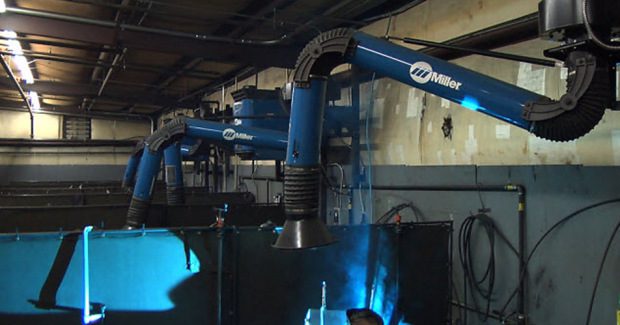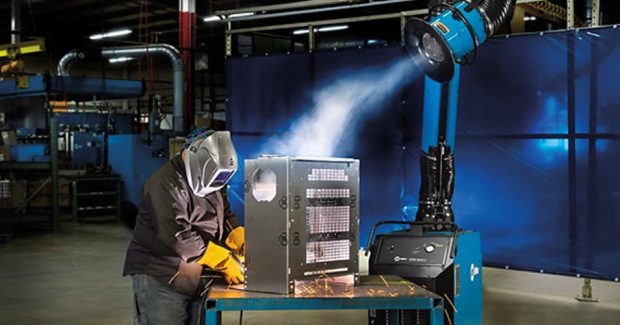Navigating OSHA’s Hierarchy of Controls to Minimize Weld Fume
In considering which weld fume management solution is right for your shop environment, be aware that it may be necessary to implement multiple solutions from the agency’s outlines to achieve the desired exposure limits for each individual metal, metal oxide or gas found in the weld plume. Here are the steps to follow.
Posted: November 4, 2014
Heightened awareness in the industry — and reduced exposure limits from agencies such as the Occupational Safety and Health Administration (OSHA) and the American Conference of Governmental Industrial Hygienists (ACGIH) — makes weld fume management a key factor in establishing and maintaining a safe, comfortable and compliant work environment. Proper weld fume management also can provide a competitive advantage in attracting and retaining skilled welding operators.
OSHA enforces exposure limits for each individual metal, metal oxide or gas found in the weld plume, such as manganese and hexavalent chromium. The agency’s Hierarchy of Controls outlines the steps employers can take in order to comply with environmental regulations and improve workplace safety. Before a company implements any steps in the hierarchy, it should first conduct air sampling within the facility with the help of a certified industrial hygienist or safety professional. Air sampling identifies they type and concentration of contaminants present in the facility.
OSHA’s Hierarchy of Controls is listed below, with examples in each category for weld fume management.
http://youtu.be/FZwO1chLAOg
STEP 1: PROCESS MODIFICATION OR SUBSTITUTION
Companies can modify welding processes (for example, shifting from Stick welding to MIG welding with a solid or metal-cored wire); change base materials; implement low-manganese filler metals; or change shielding gas to help reduce weld fume. It’s important to note that these modifications may require recertification of weld procedures. They may also require additional training and testing costs. An industrial hygienist and/or welding equipment manufacturer can help assess the best opportunities for weld fume reduction associated with this step.
STEP 2: ENGINEERING CONTROLS
In some cases, this step can require a physical change to the workspace. Engineering controls include process enclosure, general ventilation and local exhaust ventilation. Robotic welding is an example of an application that would use process enclosure to protect the operator from potential fume exposure. General (ambient) ventilation includes using an HVAC system or high-powered fans to move large quantities of air in order to dilute or filter contaminants based on an air change schedule.
Local exhaust ventilation (often referred to as source capture) includes portable and stationary fume extractors, extraction arms with centralized collectors and fume extraction guns. Source capture is the preferred method in
Step Two of the hierarchy because of its ability to capture and remove contaminants at their source before they reach a welding operator’s breathing zone. New source capture technologies, in particular, have made implementation easier for companies by creating a much larger capture area.
Fume extraction guns are another type of source capture. Fume gun acceptance has historically been limited due to weight and bulkiness of the guns. However, recent innovations have resulted in completely redesigned fume guns that closely match the weight, handle size, durability and performance of traditional MIG guns.
STEP 3: WORK PRACTICE CONTROLS
Work Practice or administrative controls do not remove hazards, but rather limit or prevent an operator’s exposure by modifying their behavior. Procedure changes and employee training are an important part of this step.
As an example of work practice controls, a weld operator should follow some basic best practices, including keeping his or her head out of the weld plume; changing body position so that the airflow moves from back to front; and making sure any air movement in the work area pushes fume away from the breathing zone.
STEP 4: PERSONAL PROTECTIVE EQUIPMENT (PPE)
This step includes implementing respiratory protection such as disposable masks, half masks, powered air purifying respirators (PAPR) or supplied air respirators. Respirators should be used if engineering controls are not feasible or do not reduce fume levels enough, or in maintenance or emergency situations. Whenever respirator use is either mandatory or voluntary, companies must establish and maintain a written respiratory protection program as stated by OSHA 29 CFR 1910.134.
Each type of respirator is given an assigned protection factor (APF), which is the level of protection it will provide when used properly, in conjunction with a written respiratory protection program. Companies must consider the respirator’s APF, air sampling results within the facility and OSHA’s Permissible Exposure Limits for those contaminants in the environment to determine which respirator is suitable. To get the most out of the respiratory protection, it is also important to ensure each employee has selected a respirator that provides a comfortable fit and does not negatively impacting productivity.
NOT ONE SIZE FITS ALL
In considering which weld fume management solution is right for an environment, be aware that it may be necessary to implement multiple solutions from OSHA’s Hierarchy of Controls to achieve desired results.
Be sure to evaluate different products, obtaining feedback along the process, to encourage welding operator involvement and expedite user acceptance. Proper employee training on weld fume management is also critical for successful execution of these controls. Whenever in doubt about steps to reduce weld fume, contact a safety professional for assistance.














